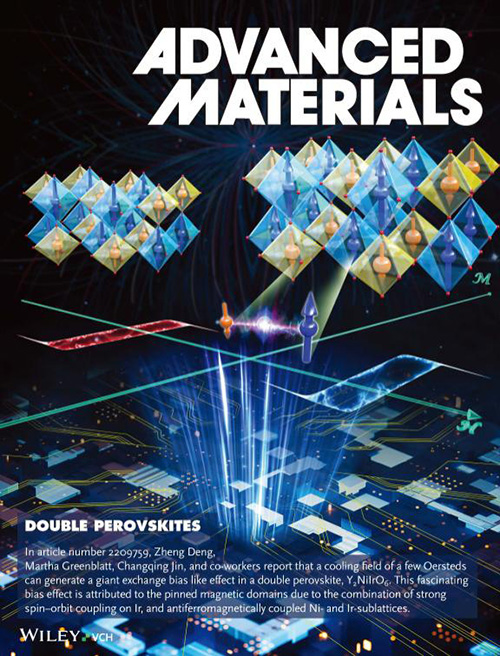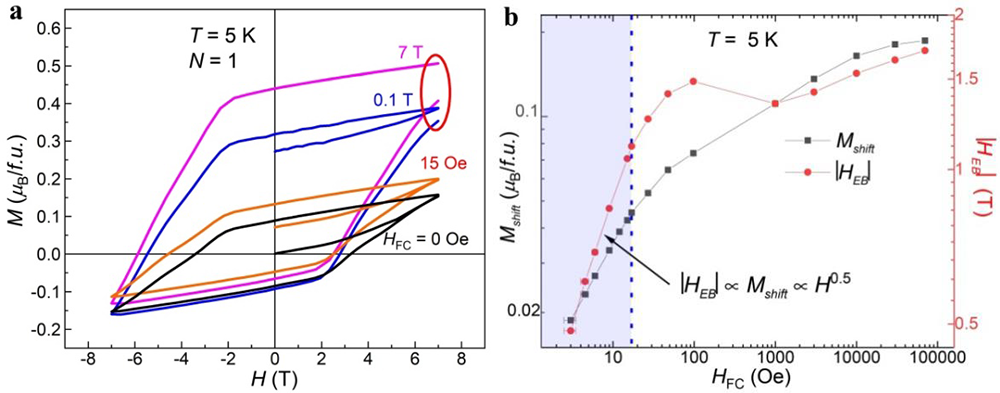Scientists Discover Giant Exchange Bias Effect at Low Cooling Fields in a High-Pressure Stabilized Double Perovskite
Date:17-05-2023 Print
Exchange bias (EB) effect has important applications in spintronic technologies. The typical examples are spin valves and magnetic tunnel junctions in high-density storages and magnetic switching for logic devices. In conventional EB heterojunctions, magnetic moments of the ferromagnetic layers are pinned by interfacial antiferromagnetic spins. Such pinned moments require extra magnetic fields for rotating the whole moments. As a result, large cooling fields are essential to obtain sufficient EB fields, adverse to the applications of EB based devices. It is necessary for applicability to achieve considerable exchange bias fields with minimum cooling fields.
Double perovskite is an excellent platform to explore exotic EB effects, owing to two different magnetic cations at B-site. High-pressure synthesis technique is widely used to stabilize the double perovskite structure.
Recently, Prof. Changqing Jin's team including associated Prof. Zheng Deng and Dr. Wenmin Li et.al. at Institute of Physics, Chinese Academy of Sciences (IOPCAS) synthesized an exchange bias effect in a double perovskite compound Y2NiIrO6 under 6 ~ 8 GPa and 1500 K for 2 hours. It shows long-range ferrimagnetic ordering below 192 K. The robust exchange bias appears at 170 K. It manifests a giant bias field of 1.1 T with a cooling field of only 15 Oe at 5 K. This fascinating exchange bias is attributed to the pinned magnetic moments by the combination of strong spin-orbit coupling on Ir, and antiferromagnetically coupled Ni- and Ir-sublattices. The pinned moments in Y2NiIrO6 are present throughout the full volume rather than those at the interface in conventional bilayers. Y2NiIrO6 requires the lowest cooling field to induce an equivalent exchange bias field in known single-phase materials, showing substantial potential for applications.
The study entitled "Giant exchange bias-like effect at low cooling fields induced by pinned magnetic domains in Y2NiIrO6 double perovskite" was published on Advanced Materials. The work was performed in collaboration with researchers from Rutgers University, Max Plank Institute for Chemical Physics of Solids and Spallation Neutron Source Science Center of China, etc. The study was supported by the National Science Foundation, the Ministry of Science and Technology of China, Chinese Academy of Sciences, Beijing Science Foundation and grants from Germany.

Figure 1 The frontispiece of Volume 35, No 17 of Advanced Materials. (Image by Institute of Physics)

Figure 2 (a) Crystal structure, (b) magnetic properties and (b) magnetic structure of Y2NiIrO6. (Image by Institute of Physics)

Figure 3 (a) Exchange bias effects of Y2NiIrO6 at low temperature with cooling fields varying from 0 Oe to 7 T; (b) Summary of cooling fields dependent exchange bias fields and vertical shifts at 5 K. (Image by Institute of Physics)

Figure 4 MFM images show domain structures at 1.6 K showing magnetic domain structures at (a) 0 T (b) 2.5 T and (c) 7 T after zero field cooling. and the scale bar is 4 μm. The blue (red) area represents the positive (negative) net magnetization and the green area represents domain walls or nonmagnetic grains. (Image by Institute of Physics)
Contact:
IOPCAS
JIN Changqing
Email:Jin@iphy.ac.cn
Key words:
cooling field; exchange bias; magnetic domain; single-phase material; spin–orbit coupling
Abstract:
Exchange bias is highly desirable for widespread technologies. Generally conventional exchange bias heterojunctions require excessively large cooling fields for sufficient bias fields, which are generated by pinned spins at the interface of ferromagnetic and antiferromagnetic layers. It is crucial for applicability to obtain considerable exchange bias fields with minimum cooling fields. Here we report an exchange bias-like effect in a double perovskite, Y2NiIrO6, which shows long-range ferrimagnetic ordering below 192 K. It manifests a giant bias-like field of 1.1 T with a cooling field of only 15 Oe at 5 K. The robust phenomenon appears below 170 K. This fascinating bias-like effect is the secondary effect of the vertical shifts of the magnetic loops, which is attributed to the pinned magnetic domains due to the combination of strong spin-orbit coupling on Ir, and antiferromagnetically coupled Ni- and Ir-sublattices. The pinned moments in Y2NiIrO6 are present throughout the full volume, not just at the interface as in conventional bilayer systems.